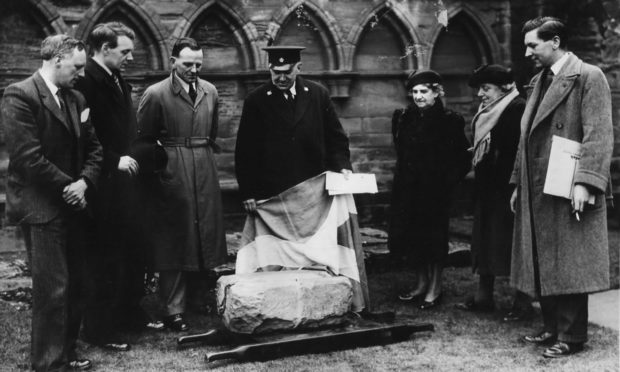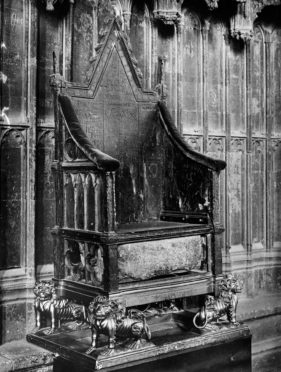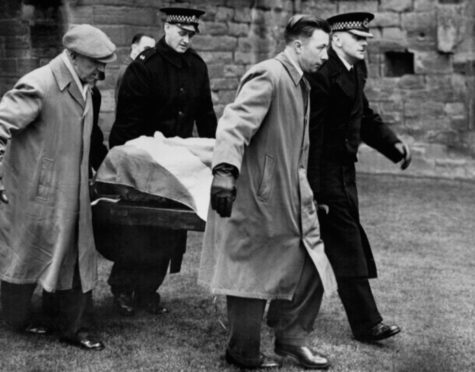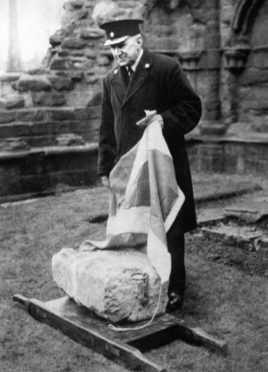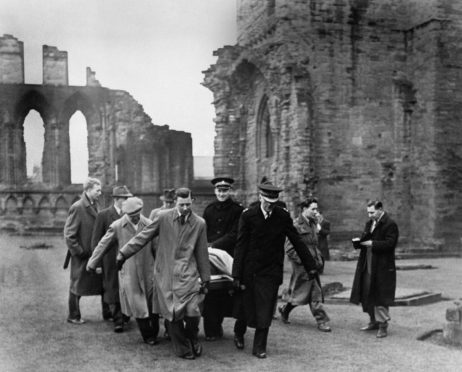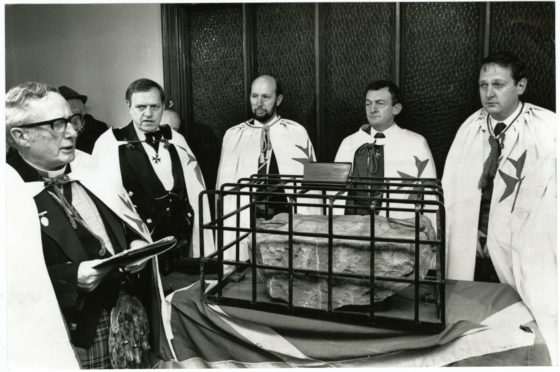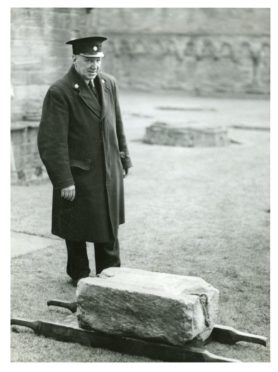The Stone of Destiny theft in 1950 forced the closure of the border between Scotland and England for the first time in 400 years.
Checks were made on hotels and boarding houses on both sides of the Cheviots as the authorities strove to find the whereabouts of the historic relic and the identity of the marauders.
Meanwhile, according to the romantics, in pubs and clubs, toasts were being given by Scottish nationalists to “the lass with the green checked coat” and “the lad with the uncombed hair”.
This meagre description had been provided by a police officer who had stumbled upon a “courting couple” in a car outside Westminster Abbey early on Christmas morning.
Later it turned out that the “lass” was 22-year-old domestic science teacher Kay Matheson and the “lad” was 25-year-old Glasgow University law student Ian Hamilton.
The ‘gang’ was made up by Hamilton’s fellow students, Alan Stuart and Gavin Vernon.
This is the story of this unlikely foursome’s venture into the history books and the remarkable episode’s eventual link with Arbroath.
Christmas Day raid became the stuff of legend
The audacious raid was just another twist in the Stone of Destiny’s life as a holy relic which was fought over by the Scottish and English for more than 700 years.
The 400lb sandstone slab, reputed to be the stone on which the Biblical Jacob rested his head, is said to be the ancient coronation seat of Scottish and Irish kings.
It was taken from the Perthshire village of Scone in 1296 by King Edward I, the “Hammer of the Scots”, and brought to London.
Edward III promised to return it under the 1328 Treaty of Northampton but rioting mobs prevented its removal, and it has been at Westminster ever since except for a brief interlude which brought consternation to post-war England.
Built into a specially constructed throne, it remained at Westminster, until the daring raid on Christmas Day 1950 which has become the stuff of legend.
The original plan was to remove it two days earlier.
Hamilton was supposed to lock himself inside the church with tools hidden in his clothing.
He was going to unscrew the locks on one of the doors and let the rest of his group inside but he was disturbed by the Westminster Abbey watchman.
The students returned on Christmas Day when the church was in darkness and took a crowbar to the a side door and jemmied the lock.
Courting couple
Weighing 150 kilos, the group managed to break the stone into two pieces when it crashed to the floor after being removed from under King Edward’s Chair.
The three men, using Hamilton’s coat, dragged the larger piece down the high altar steps, then Hamilton took the smaller fragment to the car waiting outside.
Hamilton placed the small piece in the boot of the Ford Anglia.
When a passing police officer looked vaguely suspicious of Hamilton and Matheson loitering at a getaway car, they started kissing and the pair posed as a courting couple.
The police officer, no doubt filled with the spirit of Christmas, chatted to the young “lovers” for a few minutes while taking the chance to have a fly smoke.
When they finally succeeded in smuggling the stone back to Scotland, it had to be repaired by Glasgow stonemason Robert Gray, who is long rumoured to have made copies of it.
The theft began a nationwide cat-and-mouse hunt, with the quartet successfully evading the authorities for several months.
Arthur Binnie
Many people in Scotland felt a thrill of pride at the audacity of the night raiders, but the establishment tended to deplore the way the relic had been retrieved.
The stone was stored in a variety of locations due to the intensifying police search, before the group eventually left it on the altar in the symbolic location of Arbroath Abbey, draped in a Saltire.
Arthur Binnie from the Arbroath Herald was at his desk on April 11 1951 when the phone rang with a tip that if he went to the town’s abbey he may find something of interest.
He took the office camera and cycled to the abbey, to be met by the uniformed custodian who led him silently through the abbey ruins to the high altar.
There, he found the Stone of Destiny.
He was handed an envelope with a message from the four students.
Amazingly, he had the story all to himself.
A local councillor who was supposed to alert journalists had decided to let the police know first but the officer in charge in Arbroath that day took a while to establish the story wasn’t a hoax.
Mr Binnie’s story and photographs went all over the world.
Shortly after 3pm, police arrived and four officers carried the Stone of Destiny to a waiting police van and taken to Forfar.
The stone was safely lodged in the prison part of the police station.
At 1am the stone was taken from the Forfar police cell and carried by road to Glasgow before being returned to Westminster Abbey.
The Home Secretary of the time stated it wasn’t in the public interest to prosecute the students – Ian Hamilton, Alan Stuart, Gavin Vernon and Kay Matheson.
Ever since, there were persistent rumours that the stone returned to Westminster was a cunningly-made fake and that the real stone was still concealed in Scotland.
An investigation was undertaken by officials in the early 1970s when Scottish nationalists claimed that the “real stone” was in St Columba’s in Dundee, whereas the one sent back to Westminster Abbey was a replica.
Locked inside an iron cage, it had been on display in the Lochee church since 1972 under the care of the Rev Dr John MacKay Nimmo.
Secret investigation
Government officials were concerned about publicity which would arise from interviewing people connected with the theft so they decided to check the stone in London.
This was done in secret in July 1973.
Home Office officials and Westminster Abbey staff carried out an x-ray after it was closed to the public.
The stone was moved to Poet’s Corner and x-rayed with a portable machine borrowed from the Ministry of Defence.
They were looking for rods which Robert Gray said he had used to repair the stone when it was broken during the 1950 theft.
Pictures were processed immediately and the result was shown to officials half-an-hour later.
They showed that there were three metal rods in the stone.
Investigations also included re-interviewing the Westminster Abbey’s clerk of works who had travelled to Arbroath in 1951 to confirm that it was the genuine stone that was being returned to London.
A senior police officer who was involved with transporting it south was also questioned again and submitted a statement saying he was certain it was the genuine stone that was returned.
There have been several films and programmes about the theft, most famously the 2008 Canadian-Scots feature, Stone of Destiny, starring Charlie Cox and Robert Carlyle.
On St Andrew’s Day 1996, the stone was returned to Scotland on the understanding it could be “borrowed” for any coronations at Westminster.
It is now on display, alongside the Honours of Scotland, in Edinburgh Castle, although Perth has won the fight to reclaim it after a 700-year absence.
It is hoped the ancient crowning seat can take pride of place in the new City Hall Museum, where it could attract an extra 163,000 visitors a year.
Last year, Perth and Kinross Council submitted its official bid for the stone as part of a Scottish Government consultation.
A counter bid was submitted by Historic Environment Scotland, which wanted to keep the stone where it is at Edinburgh Castle.
Key moments in the history of the Stone of Destiny
1292: John Balliol is last king to use the Stone of Destiny in Scotland.
1296: Edward I of England captures stone to Westminster Abbey.
1950: Students remove stone from Westminster Abbey on Christmas Day leaving it at Arbroath Abbey draped in a Saltire four months later.
1953: Stone used during the coronation of Queen Elizabeth II.
1996: Stone returned to Scotland and installed at Edinburgh Castle on St Andrew’s Day watched by 10,000 people.
2008: British-Canadian film starring Billy Boyd and Robert Carlyle tells the story of the 1950 student theft.
2008: First Minister Alex Salmond claims the Edinburgh Castle stone is a fake and Arbroath hoaxer claims to have found real stone.
2010: Pranksters remove a replica stone from Scone Palace, leaving it elsewhere in the grounds and replacing it with a larger block.
2013: Arbroath hoaxer admits his stone is fake and it goes on sale online.
2020: Perth wins the fight to reclaim the stone after 700 years.
